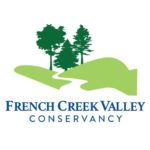Simple things you can do on your property to make the French Creek Watershed a better place!
Sponsored by Audubon Pennsylvania’s “Audubon at Home” program
Are you interested in making your piece of French Creek Watershed a better, healthier place for wildlife, your family and for the environment? Here are some ideas that will help you to make a real difference in habitat and ecosystem enhancement and quality. Remember if you want to see more wildlife and birds on your property you must provide the four basics: food, water, shelter and cover or space! Check out the simple, easy ideas below! Good luck in your landscape improvement endeavors!
Control Invasive plant species. Grapevines, multiflora rose, Japanese Honeysuckle, Garlic Mustard, Wild Parsnips, Japanese Honeysuckle, and Russian Knapweed are all examples of non-native plants that can literally take over your property. But what exactly is an invasive Species??? An Invasive is “a species that is non-native to the ecosystem and whose introduction causes or is likely to cause economic or environmental harm or harm to human health.” Many invasives are very difficult to get rid of! By the turn of the 21st century, about 1,300 species of non-native plants existed in PA. That is 37% of PA’s total plant flora. AND more non-natives are introduced each year! See DCNR’s website for a complete list including photos and descriptions of Pennsylvania’s Invasive Plant Species. PA DCNR – Invasive Plants
Avoid using insecticides, herbicides or fungicides on your property. These will not only kill targeted species, but will also kill beneficial insects and plants. Also, they will both directly and indirectly harm the wildlife on your property. Every year, 672 million birds are exposed to pesticides and suffer as much as a 10 percent mortality rate. If applied on a rainy day, pesticides can get into French Creek and its tributaries via run off.
Use integrated Pest management techniques to control pests. IPM as it’s more commonly known is the integration of management strategies to control pests. It provides a low impact, environmentally friendly alternative to chemicals to control pests and is therefore beneficial to the wildlife, water quality and habitat on your property. IPM often uses preventative techniques such as proper plant selection, monitoring, use of beneficial plants groupings and barriers. Control techniques may include hand removing pests or plants, using mulch to deter weeds, introducing or encouraging predator species (such as insect eating birds) or using less toxic compounds such as insecticidal soap solutions, pepper sprays, lime or boric acid. Integrated Pest Management (IPM)
Use native Pennsylvania plants in any landscaping project. Check to make sure plants are historically found in Northwestern Pennsylvania. (Many PA Native lists have lots of species historically found only in the southern part of the state.) *Coming soon is a French Creek Watershed Native Plant booklet—stay tuned!) WHY USE NATIVES??? Let us count the ways!!!
Native plants require less maintenance. They are adapted to local climate and conditions; require less watering and fertilizer saving both time and money. If soil and sunlight conditions are met, the plant requires little attention once established.
Native plants can handle stress. They are adapted to local growing conditions, often have stronger root systems and can handle changes such as drought, rain or pests.
Native plants meet the nutrient requirements of native wildlife. The flora and fauna of an area develop over time together and are interdependent. When we use exotic species, we often displace or eliminate native wildlife. Ninety percent of plant eating insects are specialists that have co-evolved with only one or a few plant lineages.
Natives can protect the gene pool and biodiversity in an area. Exotic species not only out compete and choke out and replace beneficial natives, they also can introduce disease strains to which natives are susceptible.
Native plants can fulfill your landscaping needs. More and more local nurseries are carrying native plants. (The French Creek Native Plant booklet will list local sources for plants.) Natural landscaping is diverse in natural beauty, brings you closer to the wonders of nature, and can help reduce mowing needs, maintenance costs and upkeep such as fertilization and pest control.
Natives can contribute to personal health. You can reduce exposure to toxic chemicals such as pesticides as well as nitrates from fertilizers for yourself, your family and your neighbors. Also with less mowing needed, you can reduce air pollution. Did you know that gas powered garden tools emit five percent of the nations air pollution?
TIP: Plan to plant native species where it will grow and thrive. A plant that requires moist soils and shade won’t thrive in a dry sunny location! This requires you to know your land and do your homework on the plants you wish to use. Imitate nature’s design for the best results. Consider emphasizing certain natural features already on your property. And plan with seasonal changes in mind so you can have blooming plants spread out over the year!
If you have questions—please give Audubon Pennsylvania a call! 814-333-1170


